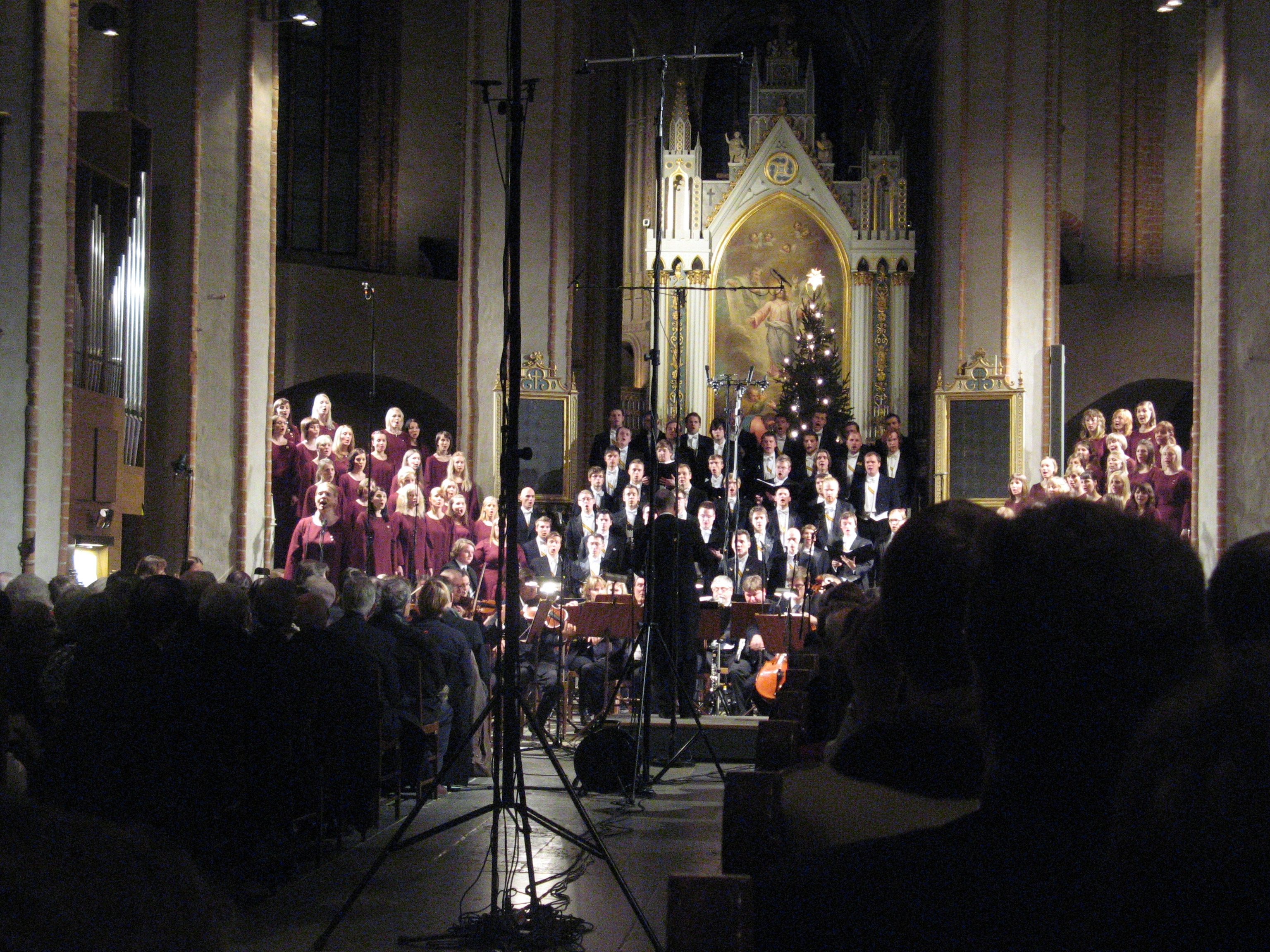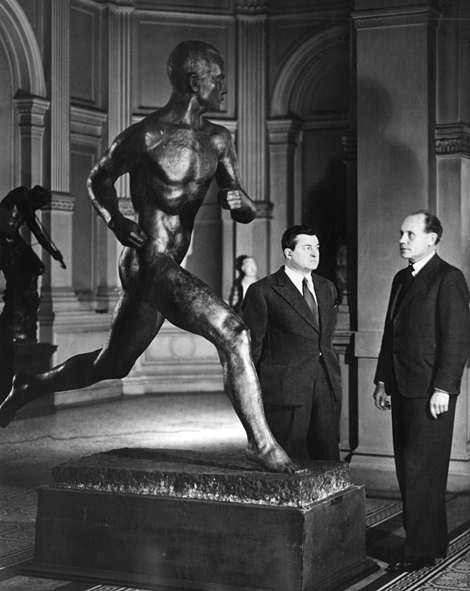|
Sibelius Museum
The Sibelius Museum ( Finnish: '''', Swedish: '''') is a museum of music, named after the Finnish composer Jean Sibelius. The museum is located close to Turku Cathedral in the historical city centre of Turku on the southwest coast of Finland. It is the only museum devoted to music in Finland. The museum houses a wide collection of historical music instruments from around the world. The archives of the museum include documents (sheet music, manuscripts, recordings, photographs, concert programmes, etc.) The museum was first founded during the 1920s as a seminar for the Department of Musicology at Åbo Akademi University, and has later developed into its own department. The Museum is currently organised and funded by the Åbo Akademi Foundation. The current building was built and opened in 1968 and it was designed by architect Woldemar Baeckman. General information The museum consists of two primary exhibitions: the instrument collection and the Sibelius exhibition. The instru ... [...More Info...] [...Related Items...] OR: [Wikipedia] [Google] [Baidu] |
Brahe Djäknar
(), also referred to as simply , abbreviated BD, is a Finland-Swedish academic male voice choir in Turku, Finland. Overview The choir was founded in 1937 and was directed by John Rosas until 1955. Rosas was succeeded by Gottfrid Gräsbeck, who was in turn succeeded by Ulf Långbacka in 1991. The choir is known for its annual Christmas concerts around the first Sunday of Advent in the Turku Cathedral together with its Åbo Akademi University Åbo Akademi University ( sv, Åbo Akademi , ) is the only exclusively Swedish language multi-faculty university in Finland (or anywhere outside Sweden). It is located mainly in Turku (Åbo is the Swedish name of the city) but has also activiti ... sister choir Florakören, and the Åbo Akademi University symphony orchestra Akademiska Orkestern. The choir also performs on 30 April every year to celebrate the coming of spring; these concerts have for many years been broadcast live on radio and TV. The choir has toured abroad freque ... [...More Info...] [...Related Items...] OR: [Wikipedia] [Google] [Baidu] |
Sibbe Atrium
Sibbe (Limburgish: ''Sub'' or ''Süp'') is the official Dutch name of a village in the municipality of Valkenburg aan de Geul in the province of Limburg in the southern part of the Netherlands. History It has been proposed that the name of the village derives from the German word sippe, meaning a clan of a limited number of families. Another possibility is that the name derives from the Latin ''cippus'', meaning young forest.J.G.M. Notten, ''Het Sibber Huis''. Valkenburg, 1995, page 9 However, both explanations do not fit with the local pronunciation ''Süp''. It is not known when the first inhabitants settled here. It is assumed that the ''Plateau of Margraten'', at the edge of which Sibbe is situated, was gradually deforested and settled after the year 1000.P.J.H. Ubachs, ''Handboek voor de geschiedenis van Limburg''. Hilversum, 2000, page 24-26, 114 The village was first mentioned ('Cybde') in a document in 1307.J.G.M. Notten, ''Het Sibber Huis''. Valkenburg, 1995, page 16 Until ... [...More Info...] [...Related Items...] OR: [Wikipedia] [Google] [Baidu] |
Wäinö Aaltonen
Wäinö Valdemar Aaltonen (8 March 1894 – 30 May 1966) was a Finnish artist and sculptor. The Chambers Biographical Dictionary describes him as "one of the leading Finnish sculptors". He was born to a tailor in the village of Karinainen, Finland. He became interested in art after being deaf as a child, and attended the School of Drawing of the Turku Art Association from age 16, or specifically between 1910 and 1915. He had spent many of the early years at this school studying painting, but he was mainly self-taught as a sculptor. He learned the technics of treatment of marble with his relative Aarre Aaltonen, and by working as a trainee stonemason in Hirvensalo. Sculptor Felix Nylund was a substitute teacher in the art school in Turku for one season, and his work was inspiration for young Aaltonen. A journey Aaltonen made to Italy in 1923 opened his eyes to cubist and futurist art. These elements can primarily be seen in his paintings. As the Republic of Finland arose, and t ... [...More Info...] [...Related Items...] OR: [Wikipedia] [Google] [Baidu] |
Robert Mattson (businessman)
Robert Emanuel Mattson (16 May 1851 – 10 May 1935) was a Finnish shipowner and businessman. Mattson was born in Åland to a shipowner family. He went to sea at young age and studied shipmaster degree. After ten years at sea he settled in Mariehamn and started trading; soon he went into shipping business. Mattson operated solely old sailing ships, which were often lost due to their poor condition. However, the business was profitable. In the 1920s Mattson changed to steam ships but could not operate them successfully. Mattson became a major owner of Helsinki-based Kone- ja Siltarakennus engineering company. The company grew rapidly but by the 1930s it had fallen into financial problems. Also Mattson's personal financial situation weakened, and following to his death, the company's main creditor sold his shares. Early years Mattson was born in Vårdö, Åland. His father Mats Mattson was a shipowner and locally influential business person. At the age of 16 Mattson, against h ... [...More Info...] [...Related Items...] OR: [Wikipedia] [Google] [Baidu] |
Folklore
Folklore is shared by a particular group of people; it encompasses the traditions common to that culture, subculture or group. This includes oral traditions such as tales, legends, proverbs and jokes. They include material culture, ranging from traditional building styles common to the group. Folklore also includes customary lore, taking actions for folk beliefs, the forms and rituals of celebrations such as Christmas and weddings, folk dances and initiation rites. Each one of these, either singly or in combination, is considered a folklore artifact or traditional cultural expression. Just as essential as the form, folklore also encompasses the transmission of these artifacts from one region to another or from one generation to the next. Folklore is not something one can typically gain in a formal school curriculum or study in the fine arts. Instead, these traditions are passed along informally from one individual to another either through verbal instruction or demonstr ... [...More Info...] [...Related Items...] OR: [Wikipedia] [Google] [Baidu] |
Magnus Dahlström
Robert Magnus Dahlström (11 April 1859 – 5 March 1924) was a Finnish businessman and philanthropist. Dahlström led trading house C.M. Dahlström together with his brother Ernst Dahlström. The trading house had ownership in number of companies, including Aura Sugar Refinery, in which Dahlström worked as manager. The Dahlström brothers donated large sums to develop cultural activities in city of Turku. They also funded foundation of the Swedish-speaking university Åbo Akademi. Career Dahlström studied first six grades in Åbo svenska klassiska lyceum until 1877, after which he studied business in Stuttgart, Germany. He did also studies in Turku art school. He returned in Turku in 1881 to work for trading house C.M. Dahlström founded by his father. He led it together with his older brother Ernst Dahlström. Magnus Dahlström led Aura Sockerbruks Ab during years 1900–1918; at the same time he was also chairman of the board. He worked also as board member of many other ... [...More Info...] [...Related Items...] OR: [Wikipedia] [Google] [Baidu] |
Aura (Archipelago Sea)
The Aura River (Finnish ''Aurajoki''; Swedish ''Aura å'') is a river in south-western Finland. Its sources are in Oripää, and it flows through Pöytyä, Aura and Lieto before discharging into the Archipelago Sea in the middle of the city of Turku. The waters of the Aura river are brown. The total length of the river is about , and it contains eleven rapids, the biggest of which is Nautelankoski at Lieto. The reserve tap water for Turku Region is drawn from the Aura, the city's secondary waterworks being situated by the Halinen rapids. The word "Aura" appears to come from an archaic Swedish word for waterway (''aathra'', which is still current in the form ''ådra''), but in Finnish it translates as "plough," a name the river lives up to. Situated in an agricultural zone, it is made turbid by surface runoff from nearby farms with eutrophication as the biggest threat. Its condition has been improving since the 1970s and the Aura river is now clean enough to support salmon. The ... [...More Info...] [...Related Items...] OR: [Wikipedia] [Google] [Baidu] |
Great Fire Of Turku
The Great Fire of Turku ( fi, Turun palo, sv, Åbo brand and russian: Пожар Або) was a conflagration in the city of Turku in 1827. It is still the largest urban fire in the history of Finland and the Nordic countries. The city had burned once before, in 1681. Description The fires started burning on 4 September 1827 in burgher Carl Gustav Hellman's house on the hill slightly before 9 p.m. The house had possibly been lit on fire by sparks flying from the chimney of a neighboring building. The fire quickly swept through the northern quarter, spread to the southern quarter and jumped the Aura River, setting the Cathedral Quarter on fire before midnight. By the next day, the fire had destroyed 75% of the city. Only 25% of the city was spared, mainly the western and southern portions. The fire destroyed the downtown area of Turku, including Turku Cathedral and the main building of the Imperial Academy of Turku, Akatemiatalo, which were badly damaged. The disaster was made ... [...More Info...] [...Related Items...] OR: [Wikipedia] [Google] [Baidu] |
Carl Linnaeus
Carl Linnaeus (; 23 May 1707 – 10 January 1778), also known after his ennoblement in 1761 as Carl von Linné Blunt (2004), p. 171. (), was a Swedish botanist, zoologist, taxonomist, and physician who formalised binomial nomenclature, the modern system of naming organisms. He is known as the "father of modern taxonomy". Many of his writings were in Latin; his name is rendered in Latin as and, after his 1761 ennoblement, as . Linnaeus was born in Råshult, the countryside of Småland, in southern Sweden. He received most of his higher education at Uppsala University and began giving lectures in botany there in 1730. He lived abroad between 1735 and 1738, where he studied and also published the first edition of his ' in the Netherlands. He then returned to Sweden where he became professor of medicine and botany at Uppsala. In the 1740s, he was sent on several journeys through Sweden to find and classify plants and animals. In the 1750s and 1760s, he continued to collect an ... [...More Info...] [...Related Items...] OR: [Wikipedia] [Google] [Baidu] |
Pehr Kalm
Pehr Kalm (6 March 1716 – 16 November 1779), also known as Peter Kalm, was a Swedish explorer, botanist, naturalist, and agricultural economist. He was one of the most important apostles of Carl Linnaeus. In 1747, he was commissioned by the Royal Swedish Academy of Sciences to travel to the North American colonies in order to bring back seeds and plants that might be useful to agriculture. Among his many scientific accomplishments, Kalm can be credited with the first description of Niagara Falls written by a trained scientist. In addition, he published the first scientific paper on the North American 17-year periodical cicada, ''Magicicada septendecim.'' Kalm wrote an account of his travels that was translated into numerous European languages; a 20th-century translation remains in print in English as ''Peter Kalm's Travels in North America: The English Version of 1770,'' translated by Swedish-American scholar Adolph B. Benson. Biography Kalm was born to Gabriel Kalm and Kata ... [...More Info...] [...Related Items...] OR: [Wikipedia] [Google] [Baidu] |






